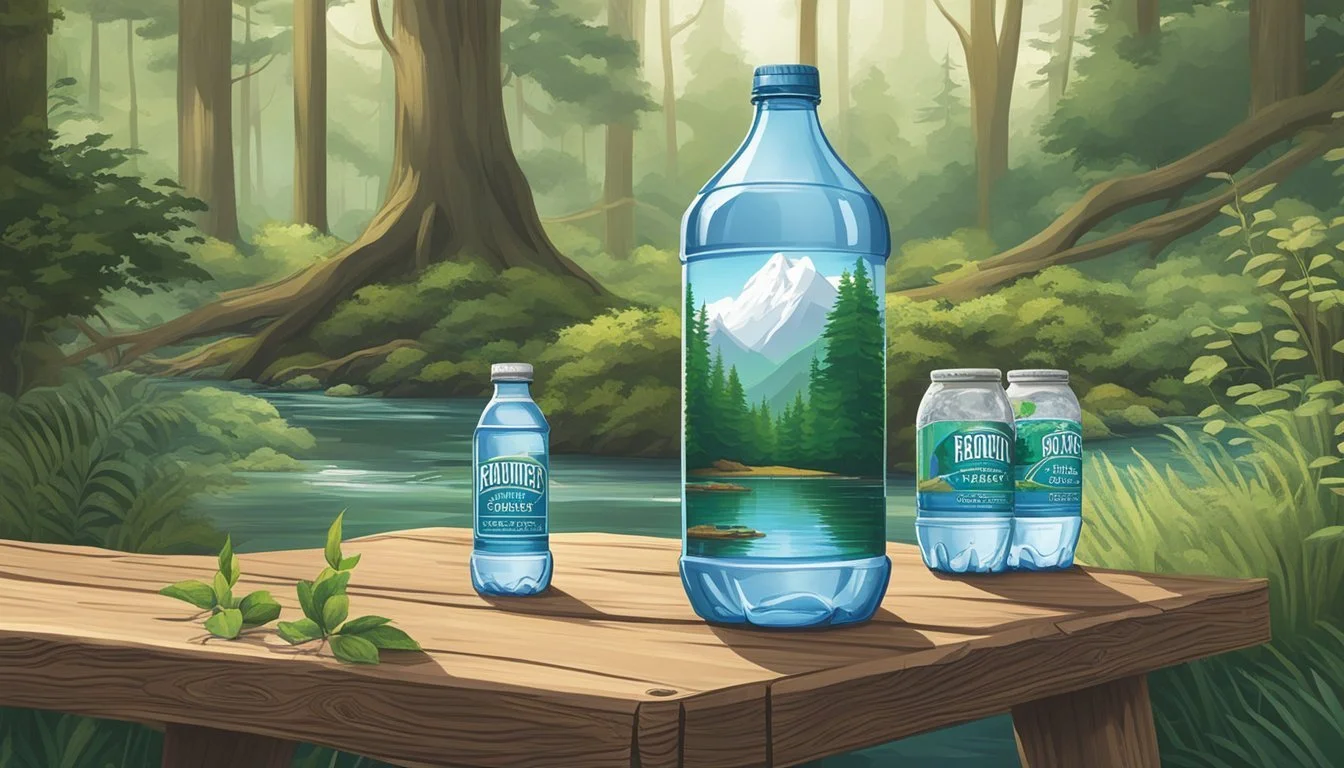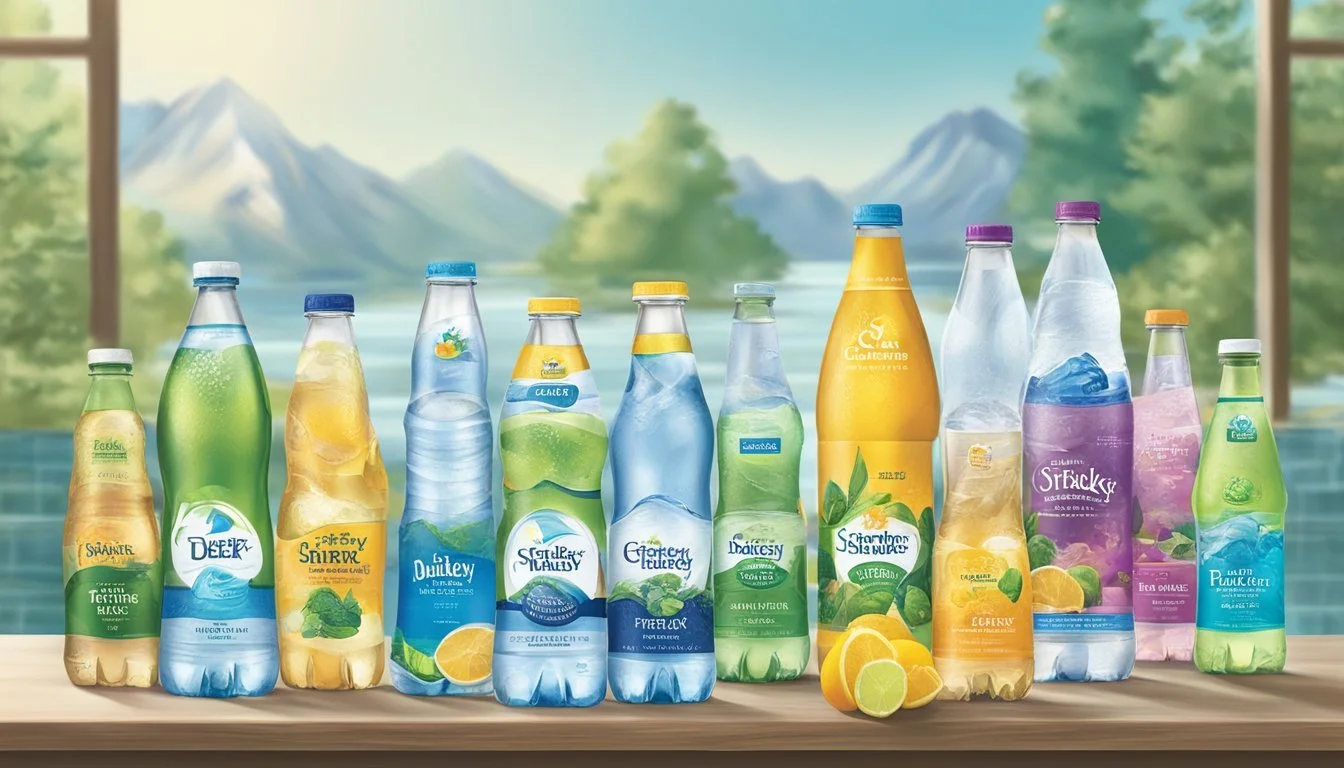Deer Park vs. Starkey
Comparing Bottled Water Quality and Taste
Choosing the right bottled water can be challenging with numerous brands vying for attention. In this post, we'll examine Deer Park and Starkey, two notable names in the industry. Deer Park offers 100% natural spring water sourced from various springs across the eastern United States, promising a crisp and clean taste. Starkey, on the other hand, prides itself on geothermal spring water sourced from Idaho, boasting a unique mineral composition.
Consumers often choose Deer Park for its reliability and consistent quality. It is widely available and has a taste profile that many people find refreshing. Starkey appeals to those looking for something a bit different, with its slightly alkaline pH and the unique mineral content that provides a distinctive taste.
When deciding between Deer Park and Starkey, it's essential to consider what matters most to you in bottled water—whether it’s the source, taste, mineral content, or availability. For those seeking a standard, crisp taste without any frills, Deer Park is a dependable choice. Starkey, with its unique mineral flavor, might appeal to those interested in exploring different water profiles.
Historical Background and Origin
Deer Park and Starkey each have rich histories rooted in their unique origins. Their distinct sources and development highlight their differences as notable brands in the bottled water market.
Deer Park: A Brief Overview
Deer Park originated in Deer Park, Maryland, following the American Civil War. In 1873, the Baltimore and Ohio Railroad created a casino near Pennsylvania where the natural spring was found.
By the late 19th century, the Deer Park Hotel added the spring water to its amenities, attracting visitors who appreciated its quality. Over time, Deer Park evolved from a local spring water source into a well-recognized brand. Today, it is produced by BlueTriton Brands and marketed primarily across the Mid-Atlantic region of the United States.
Starkey: Understanding Its Roots
Starkey Water, on the other hand, finds its origin in the Starkey Hot Springs in Idaho. Discovered in the early 20th century, Starkey's source is a geothermal spring, offering naturally filtered water with a unique mineral composition.
The water originates from deep underground, passing through volcanic rock that adds beneficial minerals. Starkey is marketed as a premium bottled water due to its natural filtration process and distinct taste. Today, Starkey Water is recognized for its commitment to quality and sustainability, maintaining its reputation as a premium brand in the U.S.
Source and Natural Composition
Deer Park and Starkey offer distinct bottled water experiences, originating from different regions and boasting unique natural mineral compositions. Below, we explore the origins of their water sources and the role natural minerals play.
Comparing the Water Sources
Deer Park sources its water from multiple springs located along the Eastern Seaboard of the United States. These springs are known for providing 100% natural spring water.
On the other hand, Starkey water originates from a geothermal spring in the remote area of the Snake River Plain in Idaho. This unique source contributes to its distinctive profile and mineral content, setting it apart from many other bottled water brands in the market.
The Role of Natural Minerals
Deer Park's natural spring water contains a variety of minerals which contribute to its crisp taste. These trace minerals include calcium, magnesium, and potassium, all essential for maintaining hydration and adding to the water's clean flavor.
Starkey, derived from a geothermal source, is naturally rich in silica and other beneficial minerals. The presence of these minerals not only impacts its taste but also supports various bodily functions, offering a smooth and refreshing drinking experience.
By understanding the distinct sources and mineral compositions of Deer Park and Starkey, consumers can better choose the bottled water that meets their specific preferences and needs.
Purification and Quality Standards
The purity and safety of bottled water are critical factors for consumers. Comparing Deer Park and Starkey requires an understanding of their purification techniques and adherence to health and safety standards.
Overview of Purification Techniques
Deer Park utilizes a process that includes several steps such as microfiltration, UV light treatment, and ozonation. These techniques help in removing impurities and bacteria, ensuring the water is clean and safe to drink.
Starkey employs a method focused on maintaining the natural integrity of the water. They use filtration to remove particles while preserving the natural mineral content, providing an authentic taste derived from their geothermal sources.
Both brands emphasize their unique approaches, which aim to balance purity with maintaining beneficial minerals. While Deer Park focuses on intensive purification, Starkey's technique is more about filtration and preserving natural qualities.
Regulatory Compliance and Safety
Regulatory compliance is paramount for bottled water brands. Deer Park adheres to regulations set by the FDA and EPA. Their water undergoes regular testing to meet strict health standards, ensuring it is safe for consumer use.
Starkey also complies with FDA regulations and emphasizes health and safety. They perform extensive testing to monitor contaminant levels, ensuring compliance with all safety standards. Their geothermal sources are regularly checked for purity.
Both brands strive to meet the highest safety standards, providing peace of mind to consumers. Regulatory compliance, coupled with rigorous testing, guarantees that both Deer Park and Starkey deliver safe drinking water.
Taste and Hydration
When comparing Deer Park and Starkey bottled waters, it's essential to evaluate their taste profiles and their effectiveness in hydrating the body. Both aspects are critical for making an informed choice between the two brands.
Flavor Profile Assessment
Deer Park water is sourced from springs across the eastern United States. It offers a crisp and clean taste, noted for its natural spring water quality. The pH level ranges from 6.3 to 8.7, providing a neutral to slightly acidic taste. This range ensures that the water is refreshing without any overwhelming mineral flavors.
Starkey is sourced from a geothermal spring in Idaho. It has a distinctly smooth taste, attributed to its balanced mineral content. Its natural alkalinity, with a pH of around 9.6, offers a slightly sweet undertone that some find more pleasing. The higher pH can also make it feel softer on the palate compared to Deer Park.
Hydration Effectiveness
In terms of hydration, Deer Park provides effective replenishment. Its balanced mineral composition from various spring sources ensures that it hydrates well without adding unnecessary elements to the body. This makes it suitable for daily consumption and rehydration after physical activities.
Starkey water's higher pH level may offer additional hydration benefits for those seeking alkaline water. Some believe that alkaline water can help with acid balance in the body and may aid in hydration. While not conclusively proven, Starkey's mineral content might offer subtle advantages for certain health-conscious individuals.
In summary, both Deer Park and Starkey offer effective hydration, with the choice often coming down to personal preference in taste and perceived health benefits.
Environmental Insights
Deer Park and Starkey bottled waters have different approaches to packaging and sustainability, as well as varied impacts on ecosystems. It is crucial to consider these factors when evaluating their environmental footprints.
Packaging and Sustainability
Deer Park: This brand has committed to using eco-friendly materials in its packaging. Many of its bottles are made from 100% recycled PET plastic, reducing the need for new plastic production. Deer Park also aims to make their entire packaging recyclable, aligning with Environmental Protection Agency recommendations.
Starkey: Starkey focuses on glass bottles, which are more sustainable than plastic. Glass, unlike plastic, is 100% recyclable and can be reused multiple times without degradation. Using glass reduces plastic waste and limits the brand’s environmental impact.
In the realm of sustainable packaging, both companies strive to minimize their carbon footprints. Deer Park's use of recycled plastic and Starkey's preference for glass represent significant steps toward sustainability.
Impact on Ecosystems
Deer Park: The water is sourced from springs mainly located in the eastern United States. While natural springs can be a renewable resource, over-extraction can impact local ecosystems. Careful management and adherence to environmental guidelines are crucial to mitigate negative impacts.
Starkey: This brand sources its water from geothermal springs in Idaho, a unique approach that taps into deep earth water sources. Geothermal sources typically have less surface impact, though monitoring and sustainable withdrawal practices are essential to avoid ecological disruptions.
Both Deer Park and Starkey recognize the importance of protecting natural water sources. By strictly managing water withdrawals and following local and federal environmental protection guidelines, they seek to minimize their ecological footprints.
Consumer Perception and Market Presence
Both Deer Park and Starkey exhibit distinctive characteristics and varying popularity among consumers. Their market presence is influenced by brand reputation and consumer trends on social media platforms like Twitter and YouTube.
Brand Reputation and Recognition
Deer Park, known for its 100% natural spring water, enjoys a positive reputation due to its consistent quality and widespread availability. It stands out for sourcing water from multiple springs across the eastern United States, resulting in a fresh and crisp taste appreciated by many. Consumers often associate Deer Park with reliability and a natural taste profile, which boosts its recognition.
Starkey, owned by Whole Foods, positions itself as a premium brand. Sourced from a single spring in Idaho, Starkey markets its water as having a high mineral content that distinguishes its taste. Its reputation leans towards a niche market—health-conscious consumers who prioritize mineral content and premium quality over price. This focus gives Starkey a distinct but smaller following compared to Deer Park.
Social Media and Consumer Trends
On social media, both brands have active engagement, but their presence varies. Deer Park often benefits from a broader demographic, frequently mentioned on Twitter and showcased in everyday use cases. The brand's reliability and affordability resonate with a wide audience, contributing to numerous positive mentions and reviews.
In contrast, Starkey's social media presence is more prominent among niche health influencers and eco-conscious consumers, especially on platforms such as YouTube. The brand's association with Whole Foods adds to its premium image, often highlighted in wellness and lifestyle content. This targeted approach garners a dedicated though smaller following compared to the more mainstream appeal of Deer Park.
Product Varieties and Innovation
Deer Park and Starkey offer unique product varieties and innovative approaches that set them apart in the bottled water market. This section examines the different variants, flavors, and technological advancements from both brands.
Variants and Flavors on Offer
Deer Park offers a diverse range of spring water products, reflecting its commitment to providing natural and refreshing options. Their portfolio includes various bottle sizes, from single-serve bottles to large multipacks, catering to diverse consumer needs. In addition to classic spring water, they also offer sparkling variations in multiple flavors, such as lemon, lime, and berry. This variety appeals to consumers seeking both plain and flavored water options.
Starkey, owned by Whole Foods, is more focused on purity and wellness, offering naturally alkaline spring water. Sourced from a geothermal spring, it boasts a unique, smooth taste. While not as varied as Deer Park, Starkey provides a more niche product aimed at health-conscious consumers, with its naturally occurring minerals and pH balance. Unlike Deer Park, Starkey does not feature flavored options, sticking to its core product of high-mineral content water.
Technological Advancements
Deer Park’s production emphasizes eco-friendly innovations. They use recycled PET (rPET) bottles, aligning with sustainability goals and minimizing environmental impact. Furthermore, advanced water filtration and quality control technologies ensure consistent taste and safety. Deer Park’s parent company, Nestlé Waters, supports research into innovative packaging and water sourcing methods, contributing to the brand’s reputation for reliability and sustainability.
Starkey emphasizes its natural sourcing from a geothermal spring, which requires minimal treatment compared to other brands. Their water undergoes a single filtration process to remove impurities while preserving natural minerals. Starkey's bottles are designed for optimal preservation of taste and quality, with efforts to maintain an eco-friendly and health-focused approach. This minimalistic yet effective processing highlights Starkey's commitment to purity and innovation in the bottled water industry.
Health Benefits and Concerns
When choosing between Deer Park and Starkey bottled waters, it's crucial to consider both the potential health benefits and risks. This section highlights essential details about minerals found in these waters and examines concerns pertaining to contaminants.
Minerals and Health
Minerals such as calcium, magnesium, and potassium in drinking water contribute to overall health. Deer Park's water, sourced from natural springs, provides trace amounts of these essential minerals. The specific mineral content can vary depending on the source spring.
Starkey water boasts a unique mineral profile, marketed for its natural mineral content. Starkey's mineral makeup may include higher levels of beneficial nutrients, but it's essential to verify these claims through independent analysis.
Minerals in Deer Park and Starkey Bottled Water:
Mineral Deer Park (Trace Amounts) Starkey (Varies) Calcium 5-10 mg/L 15-25 mg/L Magnesium 1-4 mg/L 10-20 mg/L Potassium 0.5-1 mg/L 1-3 mg/L
Concerns Over Contaminants
Contamination in bottled water, such as lead, heavy metals, and PFAS chemicals, poses serious health risks. Deer Park ensures its water is free from significant levels of contaminants through thorough testing and adherence to EPA standards. Yet, trace amounts of pollutants can occasionally be found.
Starkey, owned by Whole Foods, has faced scrutiny in the past over high arsenic levels, leading to consumer concerns. Both brands must comply with federal guidelines, but it is wise for consumers to check the most recent reports on water quality.
Key Contaminants to Watch:
Lead: Even minimal amounts can cause severe health issues.
Heavy Metals: May include arsenic, which can be harmful in excess.
PFAS Chemicals: Linked to long-term health problems, prevalent in many water sources.
Choosing between Deer Park and Starkey requires a close look at these factors. Careful consideration of mineral benefits and potential contaminant risks can guide healthier choices.
Comparison Conclusion
Deer Park sources its water from natural springs across the eastern United States. It is praised for its crisp taste and natural composition. People often appreciate its pure and refreshing qualities.
Starkey, sourced from geothermal springs in Idaho, offers a distinctively smooth taste. It prides itself on being 100% natural and mineral-rich.
Key Differences
Feature Deer Park Starkey Source Eastern U.S. Springs Idaho Geothermal Springs Taste Crisp, Refreshing Smooth, Mineral-Rich Mineral Content Moderate High Availability Widely Available Limited Availability
Bottom Line
Deer Park is best for those who prefer a crisp and readily available option.
Starkey caters to those seeking a mineral-rich, smooth water experience, although it may be harder to find in stores. Both waters offer a natural, pure choice, but personal taste preference and accessibility could determine the ideal selection.
More About Deer Park
Deer Park vs Cascade Mountain: Which Bottled Water is Better?
Deer Park vs Hawaii Volcanic: Which Bottled Water is Better?
Deer Park vs Hawaiian Springs: Which Bottled Water is Better?
Deer Park vs Icelandic Glacial: Which Bottled Water is Better?
Deer Park vs Kirkland Signature: Which Bottled Water is Better?
Deer Park vs Mountain Valley Spring Water: Which Bottled Water is Better?
Deer Park vs Nestle Pure Life: Which Bottled Water is Better?
Deer Park vs Richard's Rainwater: Which Bottled Water is Better?
Deer Park vs Solan de Cabras: Which Bottled Water is Better?
Deer Park vs Talking Rain AQA: Which Bottled Water is Better?
Deer Park vs Whole Foods 365: Which Bottled Water is Better?
Deer Park vs Whole Foods Italian Still Mineral water: Which Bottled Water is Better?
More About Starkey
Icelandic Glacial vs Starkey: Which Bottled Water is Better?
Mountain Valley Spring Water vs Starkey: Which Bottled Water is Better?
Starkey vs Kirkland Signature: Which Bottled Water is Better?
Starkey vs Richard's Rainwater: Which Bottled Water is Better?
Starkey vs Whole Foods Italian Still Mineral water: Which Bottled Water is Better?








